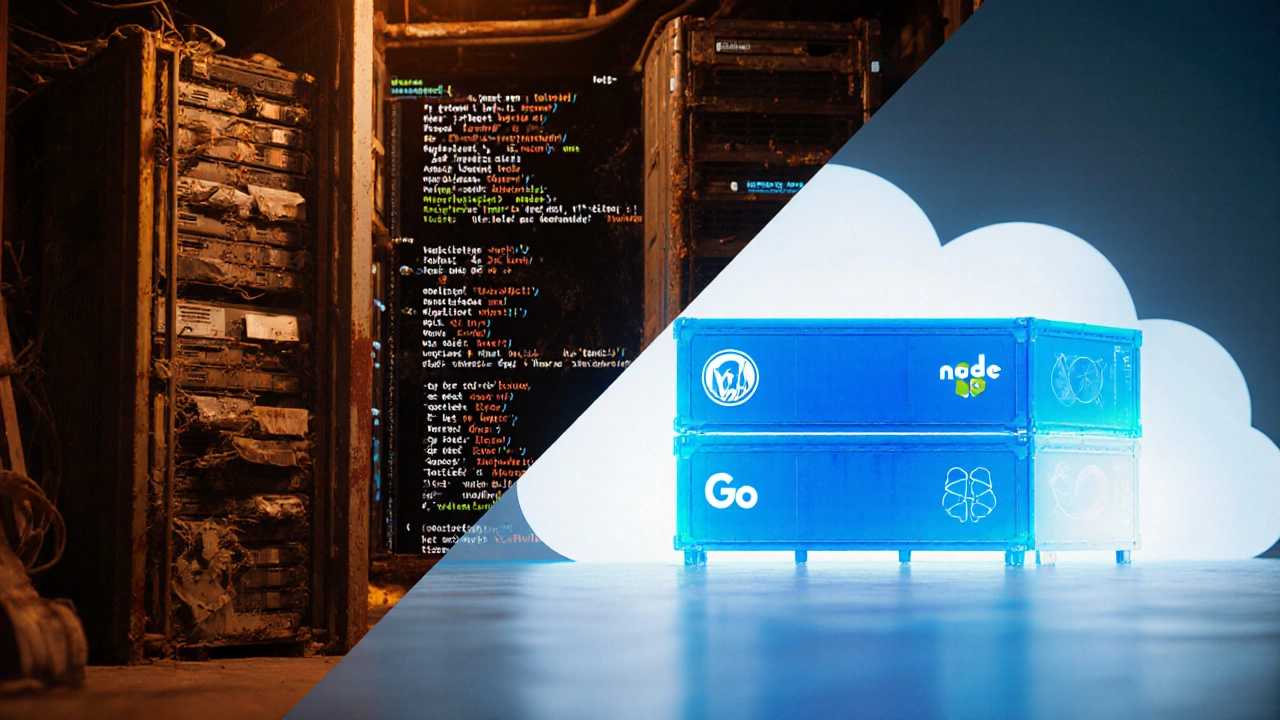PHP Alternative Selector Tool
Find Your Perfect PHP Alternative
Answer a few questions about your project to get personalized recommendations for server-side technologies that replace PHP.
If you’ve been building web sites for a while, you’ve probably heard the chorus: "PHP is dead" or "switch to something else". The reality is that PHP still powers a huge chunk of the internet, but the ecosystem has evolved and a slew of newer options now compete for the same role - delivering dynamic pages, handling APIs, and powering e‑commerce back‑ends. This guide breaks down the most popular PHP alternatives, compares their strengths, and helps you decide which one fits your next project.
Why developers look beyond PHP
PHP made the web possible in the early 2000s. It’s easy to learn, ships with most hosting providers, and has mature frameworks like Laravel and Symfony. However, modern apps demand real‑time capabilities, micro‑services, and better performance under heavy load. Those demands push teams toward runtimes that support non‑blocking I/O, stronger typing, and seamless integration with front‑end JavaScript tooling. Below we explore the top contenders that have stepped into PHP’s shoes.
Node.js - JavaScript everywhere
Node.js is a JavaScript runtime built on Chrome's V8 engine that enables server‑side execution of JavaScript code. Its single‑threaded, event‑driven architecture excels at handling many concurrent connections, making it a natural fit for real‑time apps, chat services, and API gateways. The npm ecosystem supplies over a million packages, so you can find a library for almost anything - from ORM (Sequelize) to authentication (Passport).
- Performance: High for I/O‑bound tasks, thanks to non‑blocking I/O.
- Learning curve: Low for front‑end developers already comfortable with JavaScript.
- Typical use case: Real‑time dashboards, SPAs, micro‑services.
Python - Django and Flask
Python is a high‑level, interpreted language celebrated for its readability and extensive standard library. In the web world, Django and Flask dominate. Django is a batteries‑included framework that supplies ORM, admin panel, and authentication out of the box. Flask, by contrast, is lightweight and lets you plug in only what you need.
- Performance: Good for CPU‑bound work; can be boosted with async features in recent versions.
- Learning curve: Moderate; clear syntax helps newcomers.
- Typical use case: Content‑heavy sites, data‑driven applications, scientific web tools.
Ruby on Rails - Convention over configuration
Ruby on Rails is a full‑stack web framework written in Ruby that emphasizes developer happiness through convention over configuration. Rails shines for rapid prototyping; its generators can scaffold models, views, and controllers in seconds.
- Performance: Slower than compiled languages but acceptable for most SaaS products.
- Learning curve: Higher if you’re new to Ruby, but the community offers strong guidance.
- Typical use case: Start‑ups, MVPs, and platforms that value speed of development.
Go - Speed and simplicity
Go (or Golang) is a statically typed, compiled language created at Google, known for its simplicity and built‑in concurrency primitives. Its standard library includes an HTTP server that can handle millions of requests with minimal overhead.
- Performance: Near‑C speed; excellent for high‑throughput services.
- Learning curve: Low syntactic complexity, but concepts like channels require practice.
- Typical use case: Micro‑services, cloud APIs, performance‑critical back‑ends.
Rust - Safety without garbage collection
Rust is a systems programming language that guarantees memory safety without a garbage collector. Frameworks such as Rocket and Actix‑web let you build blazing‑fast APIs while preventing common bugs.
- Performance: Comparable to C/C++; best for latency‑sensitive workloads.
- Learning curve: Steep; ownership model is a hurdle for many.
- Typical use case: Real‑time gaming back‑ends, financial services, edge compute.
.NET Core - Cross‑platform robustness
ASP.NET Core is a modular, high‑performance web framework built on the .NET runtime that runs on Windows, Linux, and macOS. It supports C#, F#, and VB.NET, offering strong typing and a rich ecosystem.
- Performance: Very high; benchmarks often place it ahead of Node.js and Java.
- Learning curve: Moderate; familiarity with C‑style languages helps.
- Typical use case: Enterprise portals, SaaS platforms, APIs that need deep Windows integration.
Java - Spring Boot for enterprise scale
Spring Boot simplifies Java’s traditionally heavyweight ecosystem by providing convention‑based defaults, embedded servers, and production‑ready features. It remains a top choice for large‑scale, transaction‑heavy applications.
- Performance: Strong; JIT compilation and mature JVM optimizations.
- Learning curve: High; the Spring ecosystem is vast.
- Typical use case: Banking systems, large e‑commerce back‑ends, complex B2B services.
Serverless - Managed functions, no servers
Platforms like AWS Lambda let you run code in response to events without provisioning or managing servers. You can write Lambda functions in Node.js, Python, Go, Ruby, or Java, paying only for execution time.
- Performance: Variable; cold‑starts can add latency, but provisioned concurrency mitigates that.
- Learning curve: Low for simple functions; architecture design becomes complex as you scale.
- Typical use case: Event‑driven APIs, image processing, chat bots.
Jamstack - Static sites with dynamic APIs
The Jamstack approach combines static site generators (like Next.js, Nuxt.js, or Hugo) with serverless functions and third‑party services to deliver fast, secure experiences. While the front‑end is static HTML, the back‑end is handled by APIs written in any language, often Node.js or Go.
- Performance: Outstanding - static assets are served from CDNs.
- Learning curve: Moderate; you need to understand both static generation and API integration.
- Typical use case: Marketing sites, documentation portals, e‑commerce front‑ends using headless CMS.
Comparison table - Picking the right tool
| Language / Framework | Runtime model | Typical performance | Ecosystem size | Learning curve | Best suited for |
|---|---|---|---|---|---|
| Node.js (Express, Nest) | Event‑driven, non‑blocking I/O | High for I/O‑bound tasks | ~1M npm packages | Easy for JS developers | Real‑time APIs, micro‑services |
| Python (Django, Flask) | Synchronous (async optional) | Good, slower than compiled | ~200k PyPI packages | Moderate | Data‑heavy sites, prototyping |
| Ruby on Rails | Synchronous MVC | Moderate | ~150k gems | Higher for Ruby newbies | Start‑ups, rapid MVPs |
| Go (standard lib, Gin) | Compiled, goroutine‑based concurrency | Very high | ~70k modules | Low syntax, concurrency concepts | Micro‑services, high‑throughput APIs |
| Rust (Rocket, Actix) | Compiled, async runtime | Top‑tier (C‑like) | ~30k crates | Steep | Latency‑critical services |
| ASP.NET Core (C#) | Compiled, cross‑platform runtime | Very high | ~1M NuGet packages | Moderate | Enterprise apps, APIs |
| Spring Boot (Java) | Compiled, JVM | Strong | ~2M Maven artifacts | High | Large‑scale, transaction‑heavy |
| Serverless (AWS Lambda) | Managed function execution | Variable (cold‑start aware) | Multi‑language support | Low for simple functions | Event‑driven tasks |
| Jamstack (Next.js + API) | Static generation + serverless | Excellent front‑end speed | Growing, JS‑centric | Moderate | Fast, SEO‑friendly sites |
How to migrate from PHP to a new stack
Switching isn’t just swapping syntax - you’ll need to consider data migration, authentication flow, and hosting. Here’s a quick checklist:
- Audit current PHP code: Identify business‑critical modules and third‑party libraries.
- Choose a target language that matches your team’s skill set.
- Map database schema changes: Most modern ORMs (Sequelize, TypeORM, Prisma) can import existing MySQL/PostgreSQL tables.
- Rewrite authentication: Use JWT or OAuth 2.0 providers instead of custom PHP sessions.
- Set up CI/CD: Containerize the new app (Docker) and configure pipelines (GitHub Actions, GitLab CI).
- Deploy to a platform that supports the runtime - VPS for Node.js/Go, Azure App Service for .NET, or serverless for event‑driven functions.
- Run performance benchmarks and monitor latency with tools like New Relic or Grafana.
When PHP still makes sense
Even after scanning the alternatives, there are scenarios where PHP remains a solid choice:
- Shared hosting is a hard requirement - most cheap hosts only support PHP.
- You’re building a WordPress or Drupal site; the ecosystems are tightly coupled to PHP.
- Your team’s expertise is deep in Laravel or Symfony, and the project timeline doesn’t allow a steep learning curve.
In those cases, stick with PHP but consider modernizing the codebase using PHP 8+ features, strict typing, and adopting Composer for dependency management.
Future outlook - where the backend is heading
The trend is clear: developers gravitate toward languages that blend performance with developer experience, and toward architectures that offload work to the edge (CDNs, serverless). Expect more projects to adopt a mix - static front‑ends on a Jamstack, business logic in Go or Rust micro‑services, and occasional serverless glue functions. PHP will evolve, but the ecosystem is diversifying, giving you a toolbox richer than ever.
Frequently Asked Questions
Is Node.js faster than PHP?
For I/O‑bound workloads like API gateways or real‑time chats, Node.js generally outperforms PHP because its event‑driven model can handle many connections without spawning threads. CPU‑heavy tasks still need careful optimization or a compiled language.
Can I run Go on shared hosting?
Most shared hosts only provide PHP and maybe Node.js. Go requires a VPS, container, or a platform‑as‑a‑service that supports compiled binaries, such as Google Cloud Run.
Do I need to rewrite the whole database when switching from PHP?
No. Most modern ORMs can connect to existing MySQL or PostgreSQL instances. You’ll just map tables to new model definitions, which is often a handful of configuration files.
What’s the biggest downside of serverless for a PHP‑style app?
Cold‑start latency can hurt response times, especially if your functions stay idle for long periods. You can mitigate this with provisioned concurrency or by keeping critical paths warm, but it adds cost.
Should I learn Rust now if I’m already comfortable with Node.js?
If your projects demand ultra‑low latency or you’re targeting edge compute, investing time in Rust pays off. Otherwise, staying with Node.js or Go is usually quicker for typical web services.

